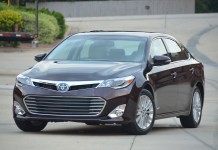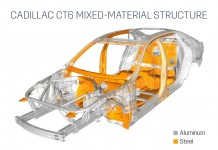The 2010 Buick LaCrosse CXS incorporates North America’s first use of a unique front suspension design called HiPer Strut. It is a premium, technologically advanced suspension design that improves ride and handling characteristics in four significant ways:
- Reduces torque steer
- Improves vehicle sensitivity to tire irregularities and wheel imbalance
- Provides more linear and communicative steering through improved camber control
- Improves impact isolation on bumps and rough surfaces.
Derived from “High Performance Strut,” the LaCrosse CXS’ HiPer Strut suspension is partnered with conventional dampers when used with the standard 18-inch wheels and an advanced electronically controlled damping system with the available 19-inch wheels.
“HiPer Strut helps reduce torque steer and maintain negative camber during cornering,” said Jim Federico, chief engineer for Buick LaCrosse. “That improves ultimate grip levels in dry and wet conditions, as well as improves the direct feel of the road, while isolating undesirable feedback. Behind the wheel the driver experiences reduced torque steer, improved grip and increased cornering power, along with crisper handling, steering precision and feedback.”
HiPer Strut is based on the MacPherson strut front suspension design and features dual-path top mountings that separate the transfer of spring and damper loads to the body structure. A combined steering knuckle/strut carrier is unique to the design. The lower control arms are attached to a rigid sub-frame that is bolted to the body structure with four isolators that reduce the transmission of noise and vibrations to the interior.
The design is also an enabler for a limited-slip differential, for even greater traction, and supports better ride quality with larger-diameter wheels – including LaCrosse CXS’ available 19-inch wheels.
“Perhaps the most significant attribute of HiPer Strut’s effectiveness is what you don’t feel,” said Federico. “You don’t feel torque steer; you don’t feel tugging or vibrations through the steering wheel; you don’t feel sharp reactions to bumps and pot holes. You simply experience a smoother, more controlled and more linear driving experience.”
The foundation
The LaCrosse’s stiff body structure is the foundation for more precise suspension tuning and the CXS’ HiPer Strut design. It is constructed with ultra high-strength steel strategically placed to enhance strength, as well as crash protection. LaCrosse CX and CXL models use a conventional MacPherson strut front suspension.
At the rear suspension, the CX, CXL and the CXS model with 18-inch wheels feature a four-link design that is mounted to the body at four points. CXS with optional 19-inch wheels and Touring Package feature a more sophisticated H-arm design that uses the same attachment points as the four-link system but with the cross member attached via isolated mounts. The lower H-arm replaces the basic trailing link, delivering a greater ride quality and lower noise.
The Touring Package also includes real-time damping and Sport Mode Selectivity, which uses four electronically controlled dampers to constantly “read” the road and make adjustments within milliseconds.
Vehicle control
Along with HiPer Strut suspension in the CXS, all LaCrosse models employ a variety of state-of-the-art systems that enable exceptional vehicle control through the steering system, brakes and more. GM’s StabiliTrak electronic stability control system is standard on all models. Additional highlights include:
- Variable effort power steering that delivers greater assistance at low speeds, such as parking maneuvers, and reduced effort at higher speeds for a greater feeling of control. The steering system has a quick, 15.2:1 ratio, requiring only 2.75 turns lock to lock.
- Four-wheel disc brakes with four-channel ABS, including large, 12.6-inch-wide (321 mm) front discs and 12.4-inch-wide (315 mm) solid rear discs. Lightweight, aluminum-body calipers are used at each corner.
- Electronic Brake force Distribution that ensures optimum braking force is applied simultaneously at both axles, for maximum stability under heavy braking; and a Brake Assist System that senses the severity of a braking situation and applies additional braking pressure when needed.







